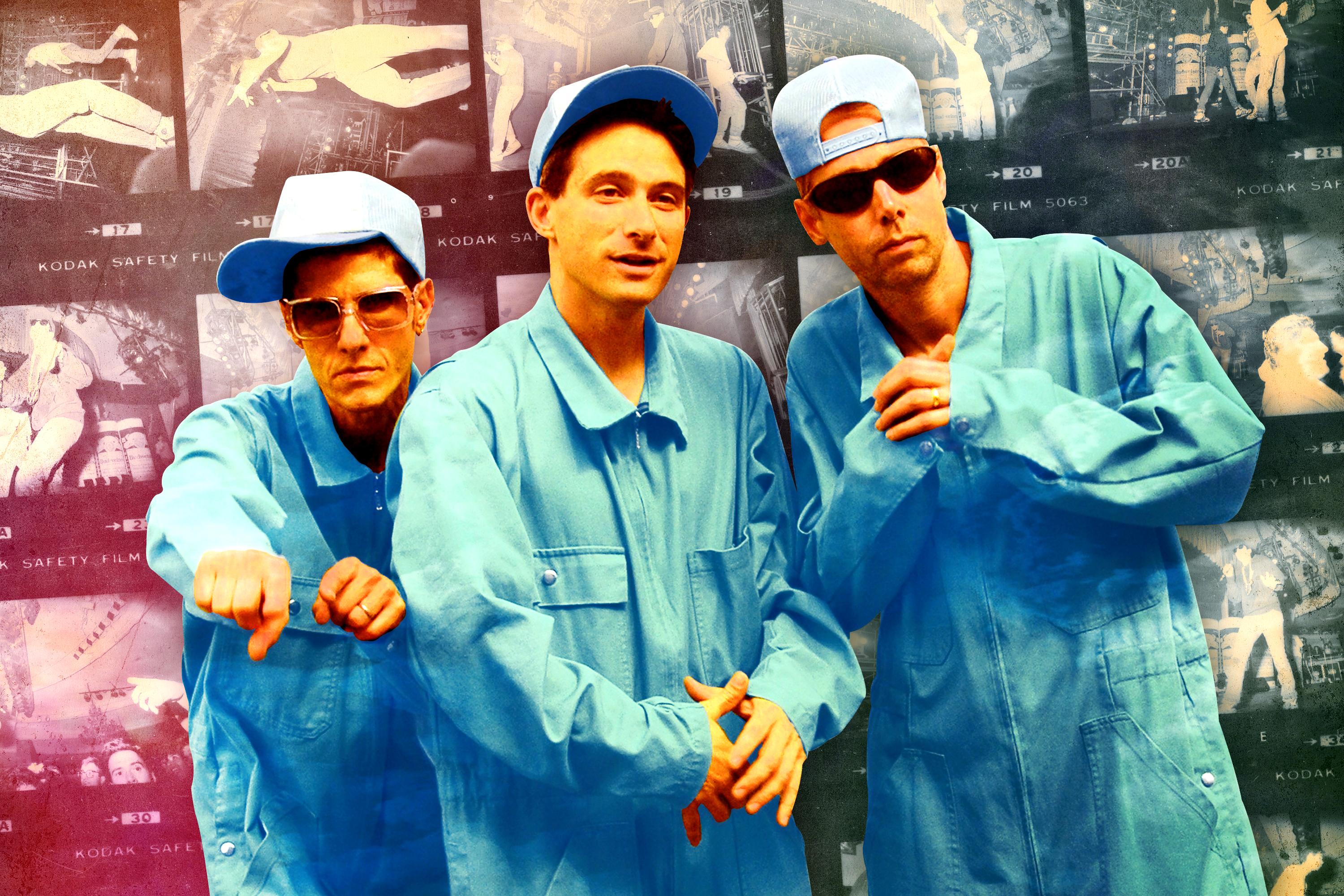
“It’s been referred to, many times, as an inflatable penis,” writes Adam Horovitz, a.k.a. Ad-Rock, addressing the sensitive matter of his famous rap trio’s most infamous stage prop. “It is not an inflatable penis. It’s a hydraulic penis.” In 1986, Licensed to Ill, the boorish and electrifying debut album from three white New York City miscreants calling themselves the Beastie Boys, revolutionized and/or gentrified hip-hop. Their first big hit: a genial little rap-rock ditty called “(You Gotta) Fight for Your Right (to Party),” which was meant to be clever (those parentheses!) but could not quite transcend its ur-frat-party boorishness. (That video!) How could the fellas possibly do this tune justice on their 1987 national headlining tour?
Like this, that’s how. Note the massive cans of Budweiser (that was their 8-foot DJ riser), and the lady dancing in the cage, and, uh, the (hydraulic) penis. “But here’s the thing I need to express,” Horovitz concludes. “You gotta really think before you say or do some dumb shit. Not always, but usually … take a moment. Think of yourself in the future looking back. Think about the people you care about most. Will they be embarrassed for you, and of you? Yes … they will think you’re an asshole.” Also, “You’ll end up paying 30 years’ worth of storage locker fees in New Jersey for a 5-foot-by-5-foot dick in a box.”
Allegedly, the New Jersey storage-locker employees still crank up the penis every year for their holiday party; the surviving Beastie Boys, Horovitz and Michael Diamond (a.k.a. Mike D.), still find themselves clarifying the whole hydraulic vs. inflatable thing to, for example, The New York Times. “The past is never dead,” wrote William Faulkner. “It’s not even past.” He was talking about something else.
On Tuesday, the gargantuan Beastie Boys Book, all 571 hardbound pages and 3.5 pounds and $50 of it, landed with a delightful thud in a boutique near you—look for the book with “PIZZA” on the cover. Written primarily by Horovitz and Diamond, it is part memoir, part photo-heavy zine, part fan-appreciation testimonial (featuring tributes and jokes and insults from the likes of Amy Poehler, Colson Whitehead, Jonathan Lethem, departed NYC DJ luminary Anita Sarko, and André Leon Talley), and part sincere apology. The loss of the third and perhaps most compelling Beastie Boy—Adam Yauch, a.k.a. MCA, who died of cancer in 2012—hangs heavy over this affair, as do a handful of youthful (and occasionally severe) transgressions. The maximum-nostalgia vibe is lovely and sweet; the vintage photos and whimsical diagrams and so forth keep all this reminiscing from bogging down. But the apologies—however brief, and however dwarfed by all the well-delivered but more conventional rock-memoir fare surrounding them—are the best parts.
The cumulative effect is awfully winsome, as gentle brand management goes. Beastie Boys Book takes care to wall off the lovable-steakhead antics of the Licensed to Ill era—overseen by visionary rap-rock producer and Def Jam label cofounder Rick Rubin, a complicated and heavy presence here even in his editorial absence—from the rest of the group’s groundbreaking career. However great a die-hard fan’s affection might still be for early jams like “Girls” or “Paul Revere,” it is a profound relief that the Beasties’ time rapping lines like this—
I said I’ll ride with you if you can get me to the border
The sheriff’s after me for what I did to his daughter
I did it like this, I did it like that
I did it with a wiffleball bat
—was relatively brief. Following a rough split from both Rubin and Def Jam, the trio regrouped with the sample-driven, insidiously fresh, moderately more enlightened innovations of their second album, 1989’s Paul’s Boutique, a minor commercial flop at the time but a critic-adored revelation in retrospect. They had a few legit smash hits—1994’s fuzzed-out and Spike Jonze–assisted “Sabotage,” 1998’s joyous funky-robot anthem “Intergalactic”—and a radiant enough rock star aura to tour arenas and pack festivals long after their peak as chart-raiding pop stars.
My personal favorite Beastie Boys memory, in fact, is from 2009, when Yauch’s cancer diagnosis forced them to pull out of their headlining gig at New Jersey’s All Points West Festival; they were replaced by Jay-Z, who kicked off his set by covering the Licensed to Ill shout-along “No Sleep Till Brooklyn,” building a roof over Liberty State Park just to tear it off. Part of what makes Yauch’s loss so painful in this book is that we don’t get to hear, in his own words, about his own particularly vivid evolution from adorable frat-rap lout to practicing Buddhist so devoted that starting in 1996 he spearheaded a series of blockbuster Tibetan Freedom Concerts. Yauch also delivered the most impactful verse in Beastie Boys history, on 1994’s “Sure Shot”:
I want to say a little something that’s long overdue
The disrespect to women has got to be through
To all the mothers and the sisters and the wives and friends
I want to offer my love and respect to the end
Those lines come up often in Beastie Boys Book, praised by, among other women in the trio’s orbit, Kate Schellenbach, the group’s drummer in their early hardcore days, awkwardly kicked out early in the Licensed to Ill era and thus the recipient of one of this project’s most necessary apologies. The nostalgia factor is fraught enough. “These days, their music makes me feel young and old at the same time,” Amy Poehler writes in the intro to a charmingly dismissive critique of the group’s music videos. “Which I am finding is a delicious space to surf.” But few ’80s-and-beyond pop superstars in any genre changed so radically and so publicly and so necessarily. And it all starts, more or less, with a song called “Cooky Puss.”
Horovitz, Diamond, and Yauch grew up as middle-class scamps in mythical wasteland of ’80s NYC; the city itself, sordid but majestic, is very much a character throughout Beastie Boys Book, in time-honored Sex and the City fashion. Musically, they started out as punk and hardcore kids who worshipped Bad Brains but soon became hip-hop kids who worshipped Run-DMC; the dividing line is 1983’s “Cooky Puss,” a half-assed punk-funk oddity dedicated to a popular and only slightly disturbing New York–area ice-cream cake. The song largely consists of Ad-Rock prank-calling the offices of Carvel, the ice-cream company in question, and mumbling, “Bitch, hang up, I’ll kick your ass, bitch” when the poor receptionist hangs up on him. “Can I formally apologize right here and now? I’m sorry,” Horovitz writes now. “There’s a definite line between funny prank call and being mean. Just randomly calling and cursing a woman out on the phone is not cool.”
“Cooky Puss” was a minor sensation in downtown NYC clubs—the Beasties’ whole world at that point. But soon they met Rubin and Def Jam cofounder Russell Simmons, Schellenbach was out, and knuckleheaded rapping was in. (Sample lyrics from “Rock Hard,” the trio’s super-butt 1984 debut rap single: “Rock ’n’ roll rhythms are raunchy and raucous / We’re from Manhattan, you’re from Secaucus.”) The Beasties’ new aesthetic—macho bravado delivered in matching tracksuits—was meant as parody, partly, maybe. But the self-awareness didn’t last. Horovitz again:
Sloppy drunk dudes trying to creep on young women was repugnant to punks in ’81. Unfortunately, when you’re a straight guy in your late teens/early twenties, you can easily fall into the stereotype’s own trappings. And we fell in. Like, from the high diving board. We got so caught up with making fun of that rock-star persona that we became that persona. Became what we hated. It got so bad we kicked Kate out of the band because she didn’t fit into our new tough-rapper-guy identity. How fucked up is that!?!
Soon came a brief but memorably traumatizing opening-act gig on a 1985 Madonna tour—traumatizing for impressionable young Madonna fans, I mean—and then Licensed to Ill and its attendant glories and charismatic aesthetic atrocities. There was the discomfort and enormous unearned advantage of the whole white-rapper thing: “MTV played the shit out of it,” Diamond writes of the “(You Gotta) Fight for Your Right (to Party)” video. “Obviously, us being white had a ton to do with that.” There were also far more direct and appalling failures of nerve and brain and heart. The rawest and most necessary apology, by far, in Beastie Boys Book is delivered by Horovitz in a brief, blunt footnote within a Licensed to Ill chapter: “The original title to this record was Don’t Be a Faggot. It was Rick Rubin’s idea, but we went along with it. It was meant to be a joke about jock frat dudes, but homophobia’s not funny and we are truly sorry.”
One of the more effective guest-star turns in Beastie Boys Book comes from journalist and author Ada Calhoun, who talks to other female Beastie Boys fans about their conflicted but devoted fandom. “Their trademark twenty-foot inflatable phallus held, for me, all the exquisite wonder of the Eiffel Tower,” recalls feminist historian Karen Abbott. “I wanted to be a dancing girl in a cage.” (It was hydraulic, Karen.)
Poehler picks up on this thread, too, in her gentle evisceration of the beach-babe clip for “She’s on It,” a best-forgotten 1985 Beastie single: “This video is so dumb. The only thing that saves it is the band is just as embarrassed by the exploitation as we are.” And when Schellenbach finally gets to write a full chapter herself—its full title is “The Girl in the Band, or, Goodbye to You and Your Inflatable Penis”—those four pages of this 3.5-pound book weigh a ton. She echoes Horovitz: “This meathead mind-set was the exact thing we’d made fun of and been disgusted by as young punks navigating NYC, so seeing them flourishing in this environment was hard to swallow.” But she also wraps up by quoting Yauch’s “the disrespect of women has got to be through” verse from “Sure Shot” in full, albeit with one last parting shot at “that meathead Rick Rubin.”
Schellenbach eventually joined another band, ’90s alt-rockers Luscious Jackson, who wound up working with Grand Royal, the Beastie Boys’ short-lived but influential vanity label, print magazine, and ambitious multimedia conglomerate. These weighty matters take up only a small percentage of Beastie Boys Book and are largely behind the group by the book’s halfway point. But they darken and sharpen and deepen the slow sonic and moral evolution that follows. The mood throughout is splendidly buoyant: Horovitz in particular is a loopy and vivid writer, whether he’s describing the process of unwinding a cassette tape as “like pulling 60 minutes of wet fettuccine out of a dog’s mouth” or praising an L.A. mansion the Beasties rented in the late ’80s: “It was butter on a roll at a shitty spaghetti place. THE BEST.”
There are some hard old-fart moments here, generationally, for those of us who grew up with the Beastie Boys, who are compelled to explain such bygone technology as landlines, the aforementioned cassettes, four-track recorders, pre-Google knowledge acquisition, pre-sampler sampling techniques, DAT tapes, a Leslie speaker (which Horovitz likens to a “psychedelic audio fidget spinner”), and floppy discs (“like iCloud, but, like, way different”). Your reward is countless musical nerd-out moments, whether Horovitz (who is married, notably, to “Riot Grrrl Manifesto” author and fellow rock star Kathleen Hanna) is rhapsodizing the likes of Lee “Scratch” Perry and Os Mutantes or revealing his personal feelings about his own catalog. (His favorite Beasties album is 1998’s Hello Nasty, his least favorite is 2004’s earnest but rigid post-9/11 love letter To the 5 Boroughs, and various individual songs on various albums made the cut via the principle of SBIA, a.k.a. “So Bad, It’s Awesome.”)
As time passes and the Boys unknowingly cross various rubicons—their last gig was headlining Bonnaroo in 2009, and their last album was 2011’s Hot Sauce Committee, Pt. 2—you brace for the heartbreaking account of Yauch’s diagnosis and death, but those details go undiscussed. “Too fucking sad to write about” is all Horovitz has to say. Instead, Beastie Boys Book climaxes with an absolutely savage and delightfully cathartic career-spanning style critique from fashion icon André Leon Talley. He starts with the Puma tracksuit era:
Oh, the boombox, oh God. Oh! This is an appropriation of the hood. This is appropriation of the hood and the street—you’re giving us like baaad hip hop, thuggerish, but it’s not thuggish enough. Oh—that little stand, that little pose. Look at that little pose. Clean sneaks—and what’s that over there? Is that like a hat or hood or snood or something?
Further judgments range from “I would say this is a look that you might find today on Grindr” to “Kraftwerk did it bett-ah” to “Didn’t you have other choices at home? Other choice of shoes?” to “This is like Adam Sandler meets Tom Hanks at a baaad former bank building in the Suburban Diaspora of New Jerrrsey” to “You look like airport workers, like people who are part of the union, who load the planes up, you know, the cargo.” This, too, in its raunchy and raucous way, counts as an apology. Thankfully, the Beastie Boys learned, the long way and the hard way, the necessity of both respecting women and disrespecting their former selves.

